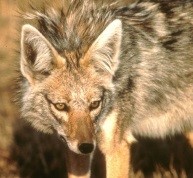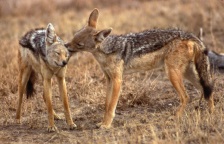
ResourcesGolden and silver-backed jackal research program (Canis aureus, Canis mesomelas): social organization, behavioural ecology, population genetics and disease


Left: golden jackal – Photo credit: Patricia D. Moehlman; Right: silver-backed jackal – Photo credit: Patricia D. Moehlman
Project:
This is a long-term program which is studying the behavioural ecology and mating system of the golden jackal and the silver-backed jackal in the Serengeti ecosystem, Tanzania. These two species typically live in adjacent habitats, the short grass plains and the Acacia sp. and Balanites sp. Woodlands. For both species the basic social unit is the breeding pair and they normally have one litter of pups per year. Genetic analyses indicate that Golden jackals are monogamous both behaviourally and genetically. Some offspring from the previous year’s litter may remain with the parents and help to raise the current litter of pups. In this study, jackals form long-term pair bonds and both members of the pair mark and defend their territories, hunt together, share food and cooperatively rear the young. Territories are maintained by a pair for up to eight years. There may be changes in boundaries and size through time. Reproductive success in golden jackals is defined as the number of pups surviving to 14 weeks of age, a time when they are weaned and have achieved moderate proficiency in foraging. Interpretation of reproductive success involves examining reproductive conflict, reproductive suppression, and the recruitment of helpers.
Researchers:
Patricia D. Moehlman – University of Florida, USA

